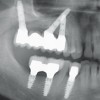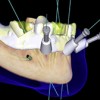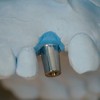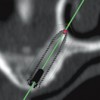Several conventional and relatively simple surgical procedures can enhance the denture bearing surfaces and facilitate the use of dentures. These include tuberosity reduction, removal of tori, frenectomy, removal of fibrous hyperplastic tissue secondary to chronic irritation, removal of undesirable boney undercuts and removal of palatal papillary hyperplasis. This program describes each of these procedures and the indications for use.
Complete Dentures – Reconstructive Preprosthetic Surgery — Course Transcript
- 1. Reconstructive Preprosthetic Surgery John Beumer III Division of Advanced Prosthodontics, Biomaterials and Hospital Dentistry UCLA School of DentistryThis program of instruction is protected by copyright ©. No portion ofthis program of instruction may be reproduced, recorded or transferredby any means electronic, digital, photographic, mechanical etc., or byany information storage or retrieval system, without prior permission.
- 2. Ideal Bearing Surfaces – Maxillav Ridge form – rounded crest with vertical sidesv Ample keratinized attached mucosav Displaceable tissues in the posterior palatal seal areav Accessible vestibulesCan any of the above be enhanced surgically?Yes. Although rarely needed, the amount of keratinizedattached tissue can be increased and the vestibulardepth can be deepened.
- 3. Ideal Bearing Surfaces – Mandiblev Broad, rounded ridge crest form with vertical sidesv Ample amounts of keratinized, attached mucosav Favorable floor of mouth posturev Anterior tongue positionCan any of the above be predictablyenhanced surgically?Yes. The amount of keratinized attached tissue can beincreased and the floor mouth posture can be changed.
- 4. Reconstructive Preprosthetic Surgery v Vestibuloplasty v Bone augmentation v Implants a)Subperiosteal b)Blade type c)Ramus frame d)Transosseus (Staple) e)Osseointegrated
- 5. Vestibuloplastyv Definiton: A surgical procedure whereby the oral vestibule is deepened by changing the soft tissue attachments .v Purpose: To increase the denture foundation area and improve the quality of the soft tissues available for support
- 6. Vestibuloplasty-Classification v Mucosal advancement (submucous resection) vestibuloplasty – The mucosa of the vestibule is undermined and advanced to line both sides of the extended vestibule. v Secondary epithelization vestibuloplasty – The mucosa of the vestibule is used to line one side of the extended vestibule, and the other side heals by growing a new epithelial surface. v Grafting vestibuloplasty – Free grafts from skin, mucosa, and dermis can be used to line one or both sides of the extended vestibule**This method is preferred because there is less relapseand the support surfaces are lined with keratinizedattached tissues.
- 7. Vestibuloplasty with Buccal Mucosa GraftsThis technique lengthens the labial and buccal vestibule butdoes not improve the quality of the tissues in the primarysupport areas. We do not recommend this procedure.
- 8. Skin Graft Vestibuloplasty Criteria for Use- Mandiblev Limited amounts of attached, keratinized mucosa lining the primary support areasv Vertical height of the mandibular body of at least 10 mmv Most of these patients present with unfavorable floor of mouth posturev Patient unable to tolerate or manipulate lower denture
- 9. Skin Graft Vestibuloplasty Obwegeser’s Methodv Supraperiosteal dissectionv Split thickness skin graftsv Lower the attachment of the mylohyoid It begins with a supraperiosteal dissection
- 10. Retrieval and Placement of the Skin GraftRetrieving graft with dermatome The graft is retrieved with a dermatone and is removed at the level of the rete pegs. Small islands of epithelium left at the donor site, expand and eventually coalesce upon healing. The graft is secured to a surgical stent, that was previously adapted to the surgical site with a temporary denture reliner, with a biodegradable adhesive. The stent is retained with circumandibular sutures and is left in place about Skin Graft 10 days Surgical stent Stent sutured in position Donor site
- 11. Lowering the Floor of the Mouthv The attachment of the mylohyoid muscle is repositionedv The boney undercut beneath the mylohyoid ridge is removed Before After Result: Increased length of the lingual flange
- 12. Skin Graft Vestibuloplasty – Results Mandibular Arch (Obwegeser Method)Note the changes. The unattached poorly keratinized mucosa hasbeen replaced with skin that is firmly attached to the underlyingperiosteum and the muscle attachments in the floor of the mouthhave been lowered. The skin lined areas improve the support forthe denture and the change in floor of posture permits a longerlingual extension enhancing stability of the denture.
- 13. Skin Graft Vestibuloplasty-Results Mandibular Archv Increased lingual flange extensionv Increased size of the denture foundation area Consequence: Improved stability and support
- 14. Skin Graft Vestibuloplasty- Morbidity Mandibular Arch v Detachment of the mentalis muscleIn this patient the dissection was overly aggressive anteriorly andthe mentalis muscle was completely detached. Little advantageis gained prosthodontically and note the drooping of the chin.
- 15. Skin Graft Vestibuloplasty- Other Problems Scar tissue atGranulation tissue Mandible the mucosa- formation skin graft- Callous mucosa formation junctionFungal infestation Perforation of the periosteum during the dissection leading to exposure of bone
- 16. Skin Graft Vestibuloplasty Mandibular Data – UCLAWould the Patients Go through the SurgeryAgain? Patients Yes . . . . . . . . . . 17 Probably . . . . . . . . 3 No . . . . . . . . . . . 4 No to the rib graft, yes to the vestibuloplasty . . . . 1
- 17. Skin Graft Vestibuloplasty Mandibular Data UCLA Sensory Innervation of the Lip PatientsNo loss . . . . . . . . . . . 7Unilateral and/or bilateral: Parasthesia, resolved . . . . 3 Anesthesia, resolved . . . . . 9Anesthesia, sensation returning . . 4Unilateral and/or bilateral: Parasthesia, unresolved . . . . 1 Anesthesia, unresolved . . . . 1
- 18. Skin Graft Vestibuloplasty Mandibular Data-UCLA Patient Evaluation of Facial Contours PatientsNo apparent change . . . . . . . . . . . . . 2Noted change: with no subjective evaluation . . . . . . . . . 6 in facial contour and is pleased except for lower lip 1 in lip and/or chin contour, does not bother patient . 9Unhappy with change in lip and/or chin contour . . . 6No comment . . . . . . . . . . . . . .1
- 19. Palatal Graft Vestibuloplasty – Maxillary Arch Palatal grafts are used when only limited amounts of graft material are needed The donor sites need about one month for complete healing
- 20. Skin Graft Vestibuloplasty – Maxillary Arch l Skin is used is when greater amounts of graft material are neededNote: Although stability is improved with this procedure seal maybe difficult to obtain because skin is not as wetable as mucosa.
- 21. Skin Graft Vestibuloplasty withCriteria for Use: l When the atrophy of the edentulous maxilla is severe l When there are no bone sites available for placement of osseointegrated implants Purpose: To improve the stability of the denture to better maintain seal.
- 22. Prong Denture – MaxillaPreop condition Postoperative view. Note the two skin lined channels. These channels extend all the way to the floor of the noseAfter supraperiosteal dissection Prefabricated prongs attached to border molded denture. Note the skin graft adapted to the denture.
- 23. Prong Denture – Maxilla Postoperative view. Note the excessive labial displacement of the upper lip.Note: The denture must be worn 24 hours a day.If the denture is removed for any extended periodthe skin lined tunnels collapse.
- 24. Ridge Augmentation – Autogenous Bone Graftsv Useful in prevention of pathologic fracturev Disappointing from a prosthodontic perspective Why? Resorption. Generally within 18 months 50% of the graft resorbs. At 10 years 80% of the graft material has been lost.
- 25. Inferior Border Rib GraftsProsthodontic Advantagesa)Widens the bearing surfaceb) Occlusal plane and interocclusalspace undisturbed
- 26. Inferior Border Rib Grafts – Problemsv Resorptionv Severance of the marginal mandibular nervev Facial disfigurement One of the marginal mandibular nerves has been severed in each of these patients. It is the result of the large incision required to place the graft. Note the distortion of the lower lip.
- 27. Visor Osteotomy preop 3 mths 2 yrs preop 3 mths 2 yrs 5 yrsThis technique uses a pedicled bone flap combined withcancellous bone grafts obtained from the iliac crest.
- 28. Visor Osteotomy – Problemsv Damage to the inferior alveolar nerve*v Resorptionv Sleep apnea secondary to posterior repositioning of the tonguev Support areas not significantly enhancedv Occlusal plane alterationsv Lack of interocclusal space anteriorly The lingual osteotomy segment became detached during healing resulting in posterior repositioning of the tongue *Damage manefest by anesthesia, hyperesthesia, and dysesthesia (seen in almost 50% of patients).
- 29. Iliac Crest Block Graft Problems: a) Resorption b) Occlusal plane descrepancies c) Limited interocclusal space posteriorly
- 30. Progressive resorption lead to many prosthodontic difficultiesa) Repeated relinesb) Repeated clinical remounts to reestablish a balanced occlusion
- 31. Augmentation with Hydroxyl Apatite Hydoxyl apatite particles are injected under the periosteum via a small tunneling incision made on the crest of the ridge anteriorly. The intent is to rebuild the alveolar process
- 32. Hydroxyl Apatite Augmentation -ComplicationsMigration of the material under pressure into undesirable areas This patient presented with hyperesthesia. The material has migrated into the area of the mental foramen. The material tends to adhere to the mental nerve leading to nerve dysfunction in some patients. In this patient the material migrated into the labial vestibule preventing proper extension of the denture in this area.
- 33. Hydroxyl Apatite – Migration In this patient the material has migrated onto the buccal shelf making this structure less effective as a primary support area. In this patient the material is beginning to extrude through the mucosa.
- 34. Implantsv Subperiostealv Bladev Ramus framev Mucosal insertsv Staplev Osseointegrated
- 35. Implants – SubperiostealDesigned to fit beneath the mucosa and atop thecortical bone. Advantages: a) Support, stability and retention provided by the implant b) Mastication efficiency improved c) Patient acceptance high
- 36. Subperiosteal ImplantsInferioralveolar nervea)Two stage surgery- impression and placement b) The restoration is implant supported c) Useful life: 5 to 10 years d) Limiting factor-epithelial migration
- 37. Subperiosteal Implants-Biologic Limitations Upon healing the metal struts of these chrome cobalt implants became surrounded by fibrous connective tissue. Upon occlusal Occlusal Load loading the collagen fibers became oriented to resist theseImplantStrut forces and formed a suspensory ligament (arrows). If the surface area of this “ligament” was insufficient to support the occlusal loads the implant was driven into the bone resulting in bone loss and sometimes leading to fracture of the mandible.
- 38. Subperiosteal Implants-Biologic Limitations The design was improved by the addition of implant struts parallel to the occlusal plane. These designs provided more support for the occlusal forces and prevented the implant from being impacted into the bone. However, this design change did not prevent the migration of epithelium along the interface of the implant strut and the fibous connective tissue capsule.
- 39. Subperiosteal Implants-Biologic Limitations The epithelial migration led to the formation of extended peri-implant pockets and eventually local infections around the implant posts and struts and ultimately, in many patients, resulting in the loss of the implant. Coating the implant with hydroxyl apatite was ineffective in preventing this migration and the material eventually was resorbed.
- 40. Subperiosteal Implants-Epithelial Migration Rate of epithelial migration: a) Increased by poor hygiene b) Decreased if implant posts exit through attached keratinized mucosa (arrows) In the patient shown above a skin graft was placed to improve the quality of Epithelial cuffs the tissues around the implant posts.
- 41. Subperiosteal Implants-Maxilla Most fail within 5 years because of fibrous encapsulation of the implant,and epthilelial migration. The chronic infections resulting from the extended pockets lead to rapid and extensive bone resorption.
- 42. Subperiosteal Implants-MaxillaThe bone loss secondary to infections associatedwith subperiosteal implants in the maxilla can bequite extensive. The patient on the left has lostalmost all the hard palate and the patient on theright has lost the premaxillary segment.
- 43. Subperiosteal Implants-Maxilla As was the case in the mandible, coating the implant with hydroxyl apatite did nothing to prevent epithelial migration and development of deep peri-implant pockets, and with these pockets, recurrent and chronic infections.
- 44. Implants – Blades These were used quite often in the 70’s and 80’s but fell out of favor because of failures associated with epithelial migration, infection and bone loss around the implants. They were used to support overlay dentures and also served as abutments for fixed partial dentures.Patient acceptance was very high in spite ofthe relatively high failure rates.
- 45. Implants-Ramus FrameA variation of the subperiosteal design Success rate was low because of epithelial migration and the lack of implant struts parallel to the occlusal plane
- 46. Implants – Mucosal Inserts The female portion of the metal mucosal inserts were surgically implanted into the mucosa and the male portion imbedded within the denture. However the mucosa inserts soon fail. This procedure is not recommended.
- 47. Transmandibular (Staple) ImplantsThis implant is made of titanium alloyand becomes osseointegrated if thesurgical site is prepared in a precise andatraumatic manner. It is designed toretain and stabilize an overlay denture. Implant success rates have been in excess of 90% at 10 year followup.
- 48. Osseointegrated ImplantsA radically new concept in implant dentistry Following placement the adjacent bone grows against the surface of these titanium implants firmly anchoring the implant in bone. When examined at the light microscopic level there is no fibrous connective tissue interface between the surface of the implant and the surface of the bone. As a result epithelial migration is prevented and the risk of chronic infection secondary to the formation of deep peri-implant pockets is almost eliminated.
- 49. Osseointegrated ImplantsPrerequisites for Successa) Pure, uncontaminated titanium implant surfaceb) Atraumatic preparation of the bone sitec) Primary implant stabilityd) Imobilization of the implant during the healing phase
- 50. v Visit ffofr.org for hundreds of additional lectures on Complete Dentures, Implant Dentistry, Removable Partial Dentures, Esthetic Dentistry and Maxillofacial Prosthetics.v The lectures are free.v Our objective is to create the best and most comprehensive online programs of instruction in Prosthodontics
Complete Dentures – Preprosthetic Surgical Procedures – Presentation Transcript
- 1. Preprosthetic Surgical Procedures John Beumer III, DDS, MS Division of Advanced Prosthodontics, Biomaterials and Hospital Dentistry UCLA School of DentistryThis program of instruction is protected by copyright ©. No portion ofthis program of instruction may be reproduced, recorded or transferredby any means electronic, digital, photographic, mechanical etc., or byany information storage or retrieval system, without prior permission.
- 2. Conventional preprosthetic surgery v Tuberosity reduction v Elimination of boney undercuts v Removal of palatal papillary hyperplasia v Frenectomy v Removal of epuli (fibrous hyperplasia secondary to denture irritation v Displacing the inferior alveolar nerve
- 3. Ideal Bearing Surfaces – Maxillal Ridge form – rounded crest with vertical sidesl Ample keratinized attached mucosal Displaceable tissues in the posterior palatal seal areal Accessible vestibules
- 4. Ideal Bearing Surfaces – Mandiblel Broad, rounded ridge crest form with vertical sidesl Ample amounts of keratinized, attached mucosal Favorable floor of mouth posturel Anterior tongue position
- 5. Mandibular Bearing Surfaces v Severe ridge resorptionConsequences:a) Impaired stability of the dentureb) Impaired support for the denturec) Pathologic fracture of the mandible
- 6. Severe Resorption – Mandiblev Definition: Loss of the mandible to the extent where 10 mm or less of the vertical height of the mandibular body remains.v Precipitating factors a) Loss of the teeth b) Ill fitting dentures c) Hormonal influences? d) Wearing dentures at night e) Edentulous mandible opposing dentate maxilla
- 7. Severe Resorption – Mandible Prevention a) Retention of roots b) Well adapted dentures with a coordinated occlusion c) Leaving out dentures at night d) Use of osseointegrated implants e) Removing opposing dentition
- 8. Mandibular Arch – Common Problems l Unfavorable floor of mouth posture and retruded tongue position Consequences: Result: Length of lingual flange a) Impaired stability is minimized b) Impaired control
- 9. Mandibular Arch – Common Problemsl Reduced amounts of attached, keratinized Consequences: Note: Usually occurs a) Impaired Support coincident with moderate to severe resorption of the alveolar ridge
- 10. Mandibular Arch – Common Problems l Thin, knife edged ridge crest Consequence: a) Impaired support b) Pain and discomfort
- 11. Mandibular Arch – Common ProblemsInferior alveolar nerve exposed on the ridge crest Consequences: a) Severe discomfort upon application of pressure b) Inability to tolerate the lower denture
- 12. Maxillary Arch – Common ProblemsSeverely resorbed, flat ridges and lack of vertical sidesPrecipitating Factors:a) Loss of teethb) Hormonal influences?c) Ill fitting denturesd) Wearing dentures at nighte) Opposing arch with natural dentitionConsequences:a) Impaired stabilityb) Difficulty in maintaining seal
- 13. Severe Resorption – Maxilla Prevention:v Retention of rootsv Well adapted dentures with coordinated occlusionv Leave dentures at nightv Use of osseointegrated implantsv Removing opposing dentition
- 14. Redundant tissues – PremaxillaThe entire premaxillary segment is fibrous connectivetissue in this patient. The underlying bone hasresorbed. It is not advisable to remove this cushion oftissue, however, because the residual ridge crestbeneath these soft tissues is likely to be knife edged.
- 15. Maxillary Arch – Common Problems Bilateral undercuts*Consequence: *Can be prevented duringa) Impaired extraction by alveolar adaptation and compression and primary retention closure (Obwegeser, 1966)
- 16. Maxillary Arch – Common Problems Low frenum attachments Consequences: a) Seal b) Fracture of denture
- 17. Maxillary :Arch – Common Problems Inflammatory palatal papillary hyperplasiaConsequences:a) Prevents proper adaptation of the denturebase compromising support
- 18. Preprosthetic Surgeryv Goals– Improve the denture foundation area so as to facilitate the support, retention, and stability provided for removable prostheses a) Minor soft tissue procedures b) Minor osseous procedures c) Vestibuloplasty d) Bone augmentation e) Implants
- 19. Conventional Preprosthetic Surgery v Epulisfissuratum removal v Frenectomy v Treatment of palatal papillary hyperplasia v Tuberosity reduction v Removal of maxillary and mandibular tori v Removal of boney undercuts v Displacing the inferior alveolar nerve
- 20. Epulis Fissuratum (Inflammatory Fibrous Etiology a) Persistent denture irritation that is not resolved Treatment a) Surgical excision and primary closure* *These lesions are generally pedunculated and are easily removed with scissors.
- 21. Low Frenum Attachments Problems: a) Seal b) FractureTreatment: Frenum are comprised of epithelium andfibrous connective tissue, not muscle, so surgicalexcision is quite effective.
- 22. Palatal Papillary Hyperplasia and AssociatedEtiology Candida Albicans Infectiona) Poorly adapted denturesb) Candida albicans *Corner of mouth usually Advanced infected with Early fungus as wellWorsened by:a) Poor oral hygieneb) Wearing dentures at night
- 23. Therapeutic Approaches – Palatal PapillaryHyperplasia**with Associated Candida Albicans Antifungal therapy* a) Nystatin powder (100,000 units per gram) Apply to undersurface of denture three times per day for 3-4 weeks b) Nystatin cream – Best used for lesions associated with the corners of the mouth c) Reline denture with temporary reline material d) Reline or remake dentureSurgical excision with electrosurgery (when antifungaltherapy has reached an end point) *Nystatin rinse is generally ineffective. Nystatin oral or vaginal suppositories used as an oral lozenge are reserved for fungal infestations that extend beyond the denture bearing surfaces. **Is this a premalignant lesion? No!!!!
- 24. Case ReportNote the chamber inscribed into the upperdenture(A) and the corresponding tissuehyperplasia. Such chambers are ill advised.
- 25. Case Report – Palatal Papillary Hyperplasia A severe case of palatal papillary hyperplasia. A combination of antifungal therapy and surgical excision is recommended for this patient.
- 26. Palatal Papillary Hyperplasia – Surgical Removal The preferred method for surgical removal is with electrosurgery. Following removal, islands of epithelium remain which grow, expand and eventually coalesce.
- 27. Hyperplastic Tuberosities Etiologic factors a) Combination syndrome -Edentulous maxilla opposing distal extension RPD where occlusion is not balanced (Inflammatory fibrous hyperplasia) b) Supereruption of unopposed molars and upon extraction the bone associated with the tuberosity is left untrimmed (arrow)
- 28. Hyperplastic Tuberosities When this patient assumes a protrusive position, the maxillary denture was tipped anteriorly leading to resorption of bone of the premaxilla and fibrous hyperplasia of the maxillary tuberosity
- 29. Enlarged Tuberosities – Criteria for Reduction Fibrous Hyperplasiav Lack of sufficient space at the proper vertical dimension of occlusion to cover both tuberositiesv Inability to extend the maxillary denture base into the hamular notchv Inability to cover the retromolar pad.v The preferred method is excision of the underlying fibrous
- 30. Conventional Preprosthetic Surgery – Boney Procedures Exostoses and toriIndications for removal:a) When they become so large as to interfere with speechb) When the mucosa becomes traumatized, ulcerates, and fails to heal because of its poor vascularityc) When the torus interferes with the design and construction of a removable partial denture or a complete denture
- 31. Palatal Tori – Criteria for Removalv Height of torus exceeds that of the alveolar ridgev Torus extends to the vibrating line preventing development of posterior palatal sealThe palatal torus on the left should be consideredfor removal while the small one on the right need notbe removed.
- 32. Removal of Palatal ToriThe torus is removed with a burr and chisel. Note thatthe mucosal flaps are supported by a palatal stent(arrow) so as to prevent formation of a hematoma.
- 33. Removal of Palatal Tori This torus was removed with a burr and chisel. The mucosal flaps should be supported by a palatal stent so as to prevent formation of a hematoma.
- 34. Mandibular Tori – Criteria for Removall Mucosa is thin and easily ulcerated and coverage by a complete denture or a major or minor connector of an RPD is usually not tolerated by the patient.Removal is accomplished with burrs and chisels
- 35. Alveoloplastyv Alveolar compressionv Reduction of the knife-edged or saw-tooth ridgev Elimination of undercuts** Study casts should be made to properly plan the procedure **Only half of the desired amount should be removed because of the resorption that follows reflection of the periosteum and the surgical removal of bone
- 36. Repositioning the Inferior Alveolar Nerve l Surgically possible, but there is risk of permanent injury to the nerve. The resultant anesthesia, dysethesia, or hyperesthesia can be quite debilitating to the patient.Preferred solution: Placement of 4-5 implants anterior to themental foramen and fabrication of a fixed edentulous bridge
- 37. v Visit ffofr.org for hundreds of additional lectures on Complete Dentures, Implant Dentistry, Removable Partial Dentures, Esthetic Dentistry and Maxillofacial Prosthetics.v The lectures are free.v Our objective is to create the best and most comprehensive online programs of instruction in Prosthodontics


 Restoration of Posterior Quadrants and Treatment Planning
Restoration of Posterior Quadrants and Treatment Planning
 Computer Guided Treatment Planning and Surgery
Computer Guided Treatment Planning and Surgery
 Cement Retention vs Screw Retention
Cement Retention vs Screw Retention
 Prosthodontic Procedures and Complications
Prosthodontic Procedures and Complications
